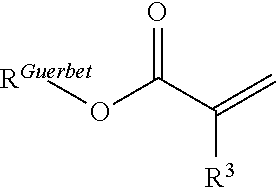Pressure-sensitive adhesives derived from 2-alkyl alkanols
a technology of pressure-sensitive adhesives and alkanols, which is applied in the direction of film/foil adhesives, adhesive types, transportation and packaging, etc., can solve the problems of not being useful by itself as a psa material, material will not be tacky, and performance requirements have become more demanding, so as to achieve low solubility parameters, unique and improved properties, and low tg
- Summary
- Abstract
- Description
- Claims
- Application Information
AI Technical Summary
Benefits of technology
Problems solved by technology
Method used
Image
Examples
examples 12-28
, Comparative Examples C8-C19 Peel Adhesive Properties of Adhesive Formulated Films
An improvement in adhesive performance using Guerbet monomers was demonstrated by carrying out peel tests of tackified and crosslinked adhesive films on multiple substrates following the procedure outlined in Test Method 5.
The failure (F) of each PSA sample is classified as adhesive failure (af), cohesive split (cs), partial cohesive split (pcs), partial transfer (pt), or ghosting (g). Samples of this series that were not tested are identified with NT.
Monomers CM 1-3, 7 and GM 1-4, 10 were each mixed using the following example formula. 28.5 g of GM 1, 0.02 g of Irgacure™ 651 (Ciba), 0.3 g of acrylic acid (AA, Alfa Aesar), and 1.2 g of hydroxyethyl acrylate (HEA, Aldrich) were mixed using a magnetic stir bar in a clear glass vial. The glass vial was then purged with nitrogen for 5 minutes to remove dissolved oxygen and then placed in front of a UV light (365 nm, ˜5 mW / cm2) until a coatable viscosity w...
examples 29-38
rties of Copolymers
Approximately 2 g of each of the blend examples of B1-B10 was mixed with 0.01 g of photoinitiator 1-651 in a small amber vial. Polymerized samples were generated and tested following the same method that was outlined in Test Method 1 above. The results are shown in table 8. In Table 8, “NO” means not observed and “NT” means not tested.
TABLE 8Thermal Transitions and mechanical properties of Blend PolymersMolarDMA AnalysisCarbonDSC AnalysisSt. ModNumberTcTmTgTg@ 25 C.FWPHExamplePolymerAverage(° C.)(° C.)(° C.)(° C.)(MPa)(° C.)29B112NONO−75−5861904030B214NONO−76−5348004431B316NONO−75−5248005032B412NONO−72−5352003633B514NONO−70−5350103634B616NONO−65−5236503735B718NTNTNTNTNTNT36B812−30−23NONO4920NO37B914−21−12NONO5840NO38B1016−15 −6NONONTNO
examples 39-68
rties of PSAs Based on Blend Monomer Formulations
PSA materials were generated using the blended preparatory examples (B1-B10) as the base monomer system in each formulation. For example 47.5 g of B1 was mixed with 2 g of hydroxyethyl acrylate, 0.5 g of acrylic acid, and 0.03 g of photoinitiator I-651. This mixture was “thickened” by partially curing the formulation under UV irradiation similar to Examples 12-28 above. Tackifier (Regalrez™ 1094, R-1094), crosslinker (XL-330), additional photoinitiator (I-651) were added at similar levels to Examples 12-28 and according to Table 9 below and allowed to mix overnight in amber vials. Each adhesive formulation was coated, cured, and tested following the same procedure outlined in Examples 12-28, as well as Test Methods 3-6. The results are shown in Table 9. In Table 9 “trans” means translucent.
TABLE 9Adhesive Properties of Blend Polymers Before and After AgingMolarR-1094180° Peel PerformancecarbonTackifierImmediately after cureAging 70° C...
PUM
| Property | Measurement | Unit |
|---|---|---|
| molar carbon number average | aaaaa | aaaaa |
| molar carbon number average | aaaaa | aaaaa |
| molar carbon number average | aaaaa | aaaaa |
Abstract
Description
Claims
Application Information
 Login to View More
Login to View More - R&D
- Intellectual Property
- Life Sciences
- Materials
- Tech Scout
- Unparalleled Data Quality
- Higher Quality Content
- 60% Fewer Hallucinations
Browse by: Latest US Patents, China's latest patents, Technical Efficacy Thesaurus, Application Domain, Technology Topic, Popular Technical Reports.
© 2025 PatSnap. All rights reserved.Legal|Privacy policy|Modern Slavery Act Transparency Statement|Sitemap|About US| Contact US: help@patsnap.com



